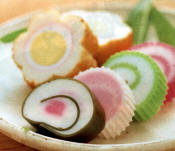Meaning of Kamaboko

Kamaboko is a variety of
Japanese processed seafood products, called surimi, in which
various white fish are pureed, formed into distinctive loaves,
and then steamed until fully cooked and firm in texture. The
steamed loaves are then sliced and served unheated (or chilled)
with various dipping sauces or sliced and included in various
hot soups, one-dish meals, or noodle dishes. Kamaboko is
typically sold in semi cylindrical, Quonset hut-shaped loaves.
Some kamaboko are made so that a slice looks like an object. The
most common pattern is a simple spiral - sometimes referred to
as "naruto" in reference to a well known tidal whirlpool near
the Japanese city of Naruto.
Pink and white kamaboko. Although the Japanese name for kamaboko
is becoming increasingly common outside of Japan (cf., sushi),
some extant English names for kamaboko are fish paste, fish
loaf, fish cake, and fish sausage (Tsuji, 1980). Tsuji
recommends using the Japanese name in English because no
adequate English name exists, other than the Jewish dish,
gefilte fish, which is somewhat similar.
Red skinned kamaboko and white kamaboko are typically served at
celebratory and holiday meals, as the red and white colors are
considered to bring good luck.
Kamaboko has been made in Japan since the 14th century CE and is
now available nearly worldwide. The simulated crab meat product
kanikama (short for kani-kamaboko), the best known form of
surimi in the West, is a type of kamaboko. In Japan, chīkama
(cheese plus kamaboko) is commonly sold in convenience stores as
a pre-packaged snack food.
-from Wiki
Advertisement
